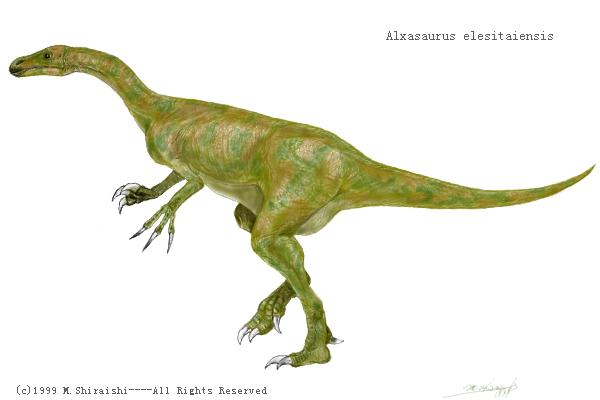|
| 질의: Alxasaurus elesitaiensis | 결과: 1번째/1 | |
Alxasaurus elesitaiensis
| 제목: | Alxasaurus elesitaiensis
| |

| 해상도: 600x400
파일크기: 19711 Bytes
등록시간: 2007:08:16 17:28:32
|
From: "stranger"
Newsgroups: han.binaries.photo
Subject: Re: (요청)공룡사진
Date: Fri, 12 Nov 1999 17:25:01 +0900
> 유치원에서 사용 할려고 합니다
> 공룡사진 가지신 분은 메일로 보내 주셔도 좋고
> 아니면 여기에 올려 주시면
> 감사합니다.
> 그럼 복된날 되세요
>
filename="Alxasaurus.jpg"
Alxasaurus (IPA: /????l??????s??????s/; "Alxa Desert lizard") is a genus of therizinosauroid theropod dinosaur from the Early Cretaceous Period of Inner Mongolia. It is one of the earliest known members of the superfamily Therizinosauroidea, but it still possessed the body shape - including the long neck, short tail, and long hand claws - of later therizinosauroids. Like other members of this group, it was a bipedal herbivore with a large gut to process plant material. Several specimens are known and the largest was a little over 12 feet (3.8 meters) long.
This dinosaur was first described and named by Canadian paleontologist Dale Russell and his Chinese colleague, Dong Zhiming, in a paper published in 1993. However, although the paper is technically included in the last issue of the 1993 volume of the Canadian Journal of Earth Sciences, this issue was actually released in the early weeks of 1994, so some sources list that as the year of publication instead.
Alxasaurus is named after the Alxa Desert of Inner Mongolia, also known as the "Alashan" desert, and the name also includes the Greek word sauros ("lizard"). Alxa (or Alashan) is also the name of the league, or administrative division, of the Inner Mongolia (Nei Mongol Zizhiqu) region of the People's Republic of China. The single known species (A. elesitaiensis) is named after Elesitai, a village found in this region, near which the fossil remains of Alxasaurus were located.
Five Alxasaurus skeletons were recovered from the Bayin Gobi Formation of Inner Mongolia, which dates to the Albian stage of the Early Cretaceous Period, or about 112 to 100 million years ago. The holotype, which is considered to exemplify the genus and species, is the largest and most complete of the five, consisting of the mandible (lower jaw) and some teeth, as well as many limb bones, ribs, and vertebrae, including all five sacral (hip) vertebrae and the first nineteen tail vertebrae. Together the skeletons represent most of the bones in the body aside from the skull.
While exhibiting many typical therizinosaur features in overall body shape and in the teeth, the skeleton of Alxasaurus also shows several features present in more typical theropods, and the discovery of this animal provided significant evidence that therizinosaurs were aberrant theropods. Specifically, the semilunate carpal bone of the wrist is found only in maniraptoran theropods, which also include oviraptorosaurs, dromaeosaurs, troodontids, and birds. Even more basal therizinosaurs such as Falcarius and the feathered Beipiaosaurus have since been discovered with more theropod features and have helped to solidify this arrangement. Alxasaurus is now thought to occupy a position between the early Beipiaosaurus and later therizinosaurs such as Erlikosaurus, Segnosaurus, and Therizinosaurus itself (Clark et al., 2004).
Text from: http://en.wikipedia.org/wiki/Alxasaurus |
 |
 |
 |
Alxasaurus elesitaiensis
1/1 |
 |
 |
^o^
동물그림창고 똑똑전화 누리집
^o^
|
|